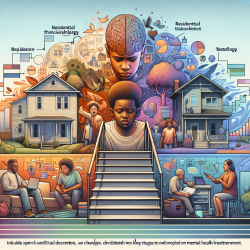Introduction
In the realm of speech-language pathology, understanding the environmental contexts in which children grow up is crucial for developing effective interventions. The research article "Mapping the Racial Inequality in Place: Using Youth Perceptions to Identify Unequal Exposure to Neighborhood Environmental Hazards" offers valuable insights into how environmental factors impact youth, particularly in racially segregated neighborhoods. This blog explores how practitioners can leverage these findings to enhance their skills and improve outcomes for children.
Understanding the Research
The study conducted by Teixeira, Zuberi, and Chakraborty uses a mixed-methods approach to explore the environmental hazards faced by youth in Pittsburgh, Pennsylvania. By engaging directly with young people, the researchers identified key environmental features that affect youth well-being, such as housing conditions, land vacancy, and community violence. These factors are disproportionately concentrated in neighborhoods with a higher percentage of Black residents, highlighting significant racial disparities.
Key Findings and Implications
The research underscores the importance of considering youth perceptions when addressing environmental inequality. The findings suggest that:
- Neighborhood Disorder: Youth identified litter, dumping, and housing abandonment as significant issues, which contribute to the stigma and negative perceptions of their communities.
- Exposure to Violence: The prevalence of crime and violence in certain neighborhoods impacts youth mental health and limits their ability to engage in outdoor activities safely.
- Racial and Economic Segregation: The study highlights the intersection of race and poverty, with Black youth facing greater exposure to environmental hazards compared to their white counterparts.
Practical Applications for Practitioners
Practitioners in speech-language pathology can apply these insights in several ways:
- Contextual Understanding: Gain a deeper understanding of the environmental contexts affecting the children you work with. Recognize that factors such as neighborhood disorder and violence can influence communication and learning.
- Advocacy and Collaboration: Collaborate with community organizations and policymakers to advocate for interventions that address environmental hazards. Support initiatives that promote safe and supportive environments for youth.
- Inclusive Practices: Incorporate the voices and perspectives of youth in program development and evaluation. This approach ensures that interventions are relevant and responsive to the needs of the community.
Encouraging Further Research
The study by Teixeira et al. opens the door for further research into the environmental factors affecting youth. Practitioners are encouraged to explore similar studies in different contexts and contribute to the growing body of knowledge on environmental justice and its impact on child development.
To read the original research paper, please follow this link: Mapping the Racial Inequality in Place: Using Youth Perceptions to Identify Unequal Exposure to Neighborhood Environmental Hazards.










